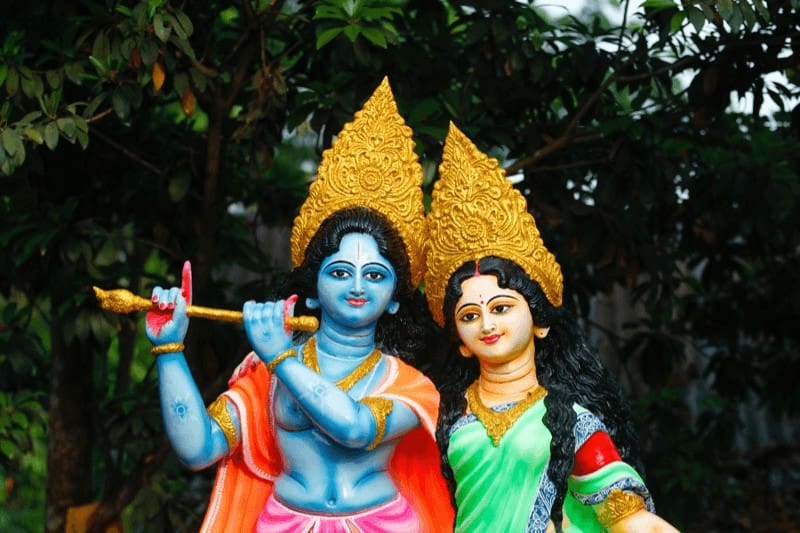Bhakti Yoga Mastery: Your Complete Guide to Devotional Practice
The post Bhakti Yoga Mastery: Your Complete Guide to Devotional Practice appeared first on The Yoga Nomads.

People choose to begin a yoga practice for any number of reasons: improving physical health and flexibility or managing stress, for example. That was the case for me before becoming a yoga teacher.
Over time, however, my practice developed into something more — I began practicing yoga for the joy I felt by coming to my mat each day, while the physical benefits became a secondary perk.
When you adopt this devotional attitude towards yoga, you are practicing Bhakti Yoga, a traditional path of yoga that emphasizes love and devotion.
This divine practice transcends the physical asana (postures) most people use to define yoga. Instead, it illuminates the way toward a deeper connection with the self, the universe, and God. And the best thing about it? You don’t need the advanced knowledge of a yoga scholar to practice Bhakti Yoga.
Less Asana, More “A-U-M”
Rather than following a standardized sequence of yoga postures with specific alignment requiring the supervision of a yoga teacher, Bhakti Yoga is a more personal, spiritual practice. You need nothing more than a genuine desire to recognize the sacred and divine meaning in your life.
Now, you must be curious about the whys and hows of Bhakti Yoga — specifically, why should you incorporate Bhakti practices into your yoga routine (short answer: because who doesn’t need a bit more grace and joy in their life?), and how do you go about it? (Spoiler alert: it’s easier than you think)!
Read on to discover how Bhakti practices can transform and add meaning to your yoga, work, and all areas of your life. Step up to the altar, fellow yogi, and let’s discover together what the Bhakti path is all about!
Origin and History of Bhakti Yoga
Bhakti Yoga is an ancient practice focused on love and devotion to a personal god or the divine. The name “Bhakti” comes from the Sanskrit root word “bhaj,” which means “to serve” or “to worship.”
Bhakti Yoga aims to build a loving, devoted relationship with a deity with the ultimate goal of spiritual enlightenment. Its various rituals and practices deepen the emotional connection to one’s own divine light and ultimate reality, or God.
The Bhagavad Gita, one of the most sacred texts of Hinduism, includes Bhakti Yoga as one of the four main paths in classical yoga. These paths include Bhakti (the path of devotion), Karma Yoga (the path of action), Jnana Yoga (the path of knowledge), and Raja Yoga (the royal path of meditation).
Defining the Bhakti Path
In the ancient Hindu text, the Bhagavad Gita, Lord Krishna teaches about the power of devotion. This is a core principle of Hinduism called the bhakti path. Other essential teachings from this sacred book include:
Surrender: Practitioners should offer their love and service to a personal god without reservation, surrendering their will with unwavering faith in the divine. Focused dedication: By concentrating the mind and heart entirely on a chosen deity, followers of Bhakti yoga can transcend reality and attain spiritual enlightenment. Acceptance: Krishna explains that Bhakti Yoga is a universal spiritual path available to anyone regardless of social class, status, or gender.The ultimate goal of Bhakti yoga is to attain spiritual liberation (moksha) through selfless love and service to the divine.
Expansion of Bhakti Over Time
Over the following centuries, Bhakti yoga developed and spread gradually, with many yoga scholars contributing to Bhakti literature and practices.
The Puranas are another group of sacred texts in Hinduism containing stories, myths, and religious teachings associated with specific deities. Along with Krishna, there are puranas devoted to Lord Shiva and Vishnu, as well as Devi, the divine mother goddess.
Bhakti practitioners find inspiration in this collection of texts, filled with hymns, prayers, and philosophical insights, to worship their personal god or chosen deity.
Connection to the Arts
Poetry and music played a crucial role in spreading the essence of Bhakti Yoga.
Alvars and Nayanars: Two groups of poet-saints in the 6th-8th centuries CE who composed devotional hymns and songs to Lord Vishnu and Shiva Akka Mahadevi: A 12th-century poet who wrote devotional songs expressing her love for Lord Shiva.Unlike many traditional mantras that use Sanskrit words, composers of Bhakti poetry and songs wrote them in the everyday language of their region and times, making their message accessible to a broad audience.
Interfaith Overlap
The origins of Bhakti Yoga lie in Hinduism. Yet, it shares similarities with many devotional practices of other spiritual traditions.
| Religion | Tradition(s) shared with Bhakti Yoga |
| Christianity | prayer, singing of hymns, individual relationship with and worship of a personal god or savior |
| Judaism | traditional ceremonies that include collective chanting and singing of sacred hymns, emphasis on loving and personal connection with God |
| Sikhism | devotional singing and worship of one God |
| Sufism | emphasis on divine love, chanting, and singing as forms of worship |
| Buddhism | meditation, deep contemplation, mantra chanting, performing acts of service, goal of attaining a state of bliss |
Krishna Consciousness Movement
Lord Krishna is a deity worshipped in Hinduism who is often associated with love, divine joy, and, of course, Bhakti yoga.
A prominent modern form of Bhakti Yoga is dedicated to Krishna himself. The Krishna Consciousness Movement, or International Society for Krishna Consciousness, was founded in 1966 in New York and is quite influential in preserving tradition and sharing the wisdom of the Bhakti way.
Followers of this movement consider Krishna to be the Supreme Being and source of all creation. He is a role model for his devotees, called Hare Krishnas, as they strive to embody his ideal qualities of compassion, grace, love, and wisdom.

Core Principle: The Devotional Attitude of Bhakti Yoga
Bhakti Yoga is about devotion, shown through practices such as chanting and meditation. This form of yoga emphasizes surrender to a higher power for self-realization and inner peace.
Expressing Devotion Through Various Practices
Unlike other styles of yoga, Bhakti is less about practicing asana (postures) and more about kindling the divine light within. What ignites one individual’s heart and soul with joy may differ from person to person. Luckily, in Bhakti yoga, there are a number of ways to express your devotion.
Mantras, or sacred chants, are often used to invoke divine love. Some might chant the names of Lord Krishna or Vishnu, while others may prefer different deities. Prayer and meditation also play significant roles. These practices allow devotees to connect with their personal god or goddess. Building a simple altar or sacred space in the home in honor of a deity is another way devotees can practice Bhakti.
Surrendering to a Higher Power
In Bhakti Yoga, surrender isn’t a sign of weakness; it’s an act of faith. The tradition teaches that by surrendering our ego to a higher power – be it a personal god or goddess or any deity – we can experience divine light within ourselves, the union of Atman (the soul) with God.
The Path to Self-Realization
The Bhakti path isn’t about reaching an external destination; it’s about traveling inward and connecting to the divine light within us. The idea is that incorporating sacred practices into day-to-day life enables one to see the divine in everything around them. Devotees of Bhakti yoga believe this ultimate goal brings inner peace and divine bliss.
Stages of Devotion in Bhakti Yoga
Aparabhakti and Parabhakti
The spiritual practice of Bhakti Yoga starts with aparabhakti. This stage is about external action. It’s the beginning of the Bhakti path, where devotees show love towards deities through rituals and ceremonies.
Then comes parabhakti. This higher phase is all about internal worship. Here, there is less emphasis on ritual as the devotee can express their love and devotion through every action they take.
Nine Stages of Devotion
According to sacred Bhakti texts, there are nine stages of devotion. Each stage builds upon the one before it until one reaches the final phase of complete surrender to the divine.
Shravanam: Listening to stories about God. Kirtanam: Singing or chanting God’s name. Smaranam: Remembering God constantly. Padasevanam: Serving God’s feet (a metaphor for service). Archana: Worshiping an image or icon of God. Vandanam: Offering prayer to God. Dasya: Becoming a servant of God. Sakhya: Developing friendship with God. Atmanivedana: Complete surrender to God.Each stage takes the devotee deeper into their spiritual journey, fostering a stronger bond with the divine.
The Role of Guru
To progress on the spiritual path, a devotee needs guidance from a guru or teacher. The guru helps the devotee cultivate a devotional attitude and move through the stages from aparabhakti to parabhakti.
In the Bhagavad Gita, Krishna speaks to the importance of seeking instruction and insight from a qualified teacher. According to Krishna, the role of the guru includes:
Guidance and wisdom: As a source of divine knowledge, the guru helps their student deepen their understanding of Bhakti, ultimate reality, and enlightenment. Preserving tradition: The guru-student relationship is essential for passing down sacred knowledge, traditions, and Bhakti practices from one generation to the next. Discipline in practice: In following the example of their guru, the student develops consistency and discipline in their Bhakti practice. Furthermore, offering service and obedience to a guru is a form of surrender, a core aspect of Bhakti yoga.Methods and Practices in Bhakti Yoga

Standard Practices of Bhakti Yoga
Bhakti yoga involves several practices. These include mantra repetition, visualization, and ritual worship.
Mantra repetition is chanting sacred words or phrases, sometimes using musical instruments. It’s like a spiritual jam session! Meditation: A practice where an individual uses a technique or path to achieve mental clarity. Visualization involves picturing divine entities. Think of it as daydreaming with a holy twist. Ritual worship respects the divine through ceremonies, such as prayer meetings or group discussions of religious texts and teachings.Paths within Bhakti Yoga
There are different paths in bhakti yoga, too. Each path offers its unique way to connect with the divine.
Shanta (Peaceful Love) is all about calmness, bringing a sense of tranquility into one’s connection with God. Dasya (Servitude) focuses on serving the divine. Sakhya (Friendship) promotes forming a dear friendship with God. Vatsalya (Parental Love) encourages treating the divine like your child, showing love through care and protection. Madhura (Conjugal love) fosters romantic feelings towards the divine, treating your personal god as you would your beloved.Each path has its traditions and mantras that practitioners follow. Bhakti devotees may choose the way they express their love for God in a way that suits their individual preferences and personal spiritual practice.
Connection with The Divine
These methods help foster a deep connection with the divine. They enable you to feel closer to God, whoever you perceive them to be.
For instance, mantra repetition can make you feel like you’re conversing with God. Visualization can create an image of divinity in your mind’s eye.
The different paths offer various ways to relate to the divine. We all have something we can relate to, like helping others, friendship, or love from family and partners.
Role of Kirtan and Archana in Bhakti Yoga

Bhakti Yoga is all about devotion. Two critical parts of this are Kirtan and Archana.
What is Kirtan?
Kirtan, by definition, is communal singing or chanting, often with music thrown in. This is different from your typical choir practice, though! The melodies and rhythms can be simple or complex, but they’re always powerful.
Think about it – when you’re belting out your favorite tune with others, don’t you feel a sense of unity? That’s the power of Kirtan — the power of many voices coming together intensifies and deepens the spiritual experience.
Archana: Intentional Actions
Now, let’s talk about Archana. This is ritualistic worship, where devotees make offerings to deities. These offerings could be flowers, food, incense – anything that shows respect and devotion.
It might sound fancy, but it’s pretty straightforward. Set up a simple altar, light a stick of incense or a candle, and there you go! You’re just showing some love to the divine through these gestures.
Why Kirtan and Archana Matter
So what is so special about Kirtan and Archana in Bhakti Yoga? Why have these traditions endured for centuries?
Well, they help cultivate devotion and community spirit. When people come together to chant or make offerings, this shared love and respect for the divine multiplies. It’s like being part of a team where everyone’s working towards the same goal.
And hey, modern science backs this up, too! Research has found that participating in group activities like Kirtan — in person or online — can increase social connection and emotional well-being.
So there you have it – these traditions of Kirtan and Archana have stood the test of time and are still relevant in modern-day Bhakti Yoga practices. They’re more than just rituals; they offer means of building community spirit and fostering devotion.
Any activity that brings people together, encouraging love, joy, and togetherness, is truly wonderful! Don’t you agree?
Benefits and Impact of Bhakti Yoga
Physical Perks
Now, you might be wondering, since there is less emphasis on physical asana in bhakti yoga — are there physical benefits to the practice?
This form of yoga can be a real game-changer for your body. It helps reduce stress and lower blood pressure, significant issues in today’s fast-paced world. Plus, consistent Bhakti practice improves focus through meditation and concentration.
So, the physical perks of Bhakti yoga might not be noticeable from the outside of your body, but you’ll feel a difference internally in your heart and mind!
Emotional Boosts
But wait, there’s more! Bhakti yoga isn’t just good for your body; it also boosts your emotions. Incorporating devotional practices like prayer or chanting mantras each day increases compassion and supports mood stability.
Modern science backs these positive effects:
In one study, adults with chronic mental health issues who participated in choir singing and creative writing (for example, writing poetry) experienced an easier time regulating their emotions. Another study reported that after a three-month Bhakti Yoga intervention, participants experienced reduced anxiety and fewer symptoms of depression.This scientific evidence reinforces why these practices have stuck around for so long — they work!
Spiritual Growth
Here’s where Bhakti yoga shines — the spiritual benefits. It takes you on a journey towards heightened self-awareness. You get to know yourself better than ever before.
It deepens your understanding of divine love and connection with God or your higher power, leading to spiritual growth.
And the best part? It’s completely customizable: how you practice Bhakti, the traditions you follow, and the deities you worship are all up to you. It is an individual spiritual practice that can take many forms. This is what makes Bhakti yoga genuinely unique and powerful.
Embracing Bhakti Yoga Practice
Bhakti Yoga is a unique path to spiritual enlightenment. It has a rich history and profound principles of devotion. This practice helps you grow and understand yourself by focusing on love, faith, and surrender.
The various stages of devotion in Bhakti Yoga offer practitioners structure for deepening their spiritual journey. Kirtan and Archana play significant roles in this practice, enhancing the experience through music and communal worship. The benefits of Bhakti Yoga are not limited to spiritual growth alone; they also extend to mental and emotional well-being.

Tips for Beginning a Bhakti Yoga Practice
So, are you interested in exploring Bhakti Yoga but unsure where to start? Here are some ideas to get you going!
Spend some time reading about the deities in Hinduism and consider which personal god or goddess you might enjoy devoting your practice to. Shiva and Vishnu are popular choices, but you can choose one that resonates with you! Create a small altar in your home with a photo of your chosen deity. Take a bit of time each day to light a candle or incense stick and say a prayer of gratitude to the divine. Check your local area for temples or yoga studios that offer group mantra chanting sessions. Remember, these may be accessible online as well! Become a Bhakti yoga scholar by reading a classic text, like this Bhagavad Purana book.Engaging in Bhakti Yoga can lead to transformative experiences that enrich life on many levels. We invite you to explore this ancient practice further and discover how it can help you navigate your spiritual journey.
Remember that every step toward self-discovery is a step toward greater peace and fulfillment.
FAQ 1: What is the main focus of Bhakti Yoga?
The main focus of Bhakti Yoga is devotion or love towards a higher power or divine entity. It emphasizes emotional engagement over physical postures.
FAQ 2: How does Kirtan contribute to Bhakti Yoga?
Kirtan is a central practice in Bhakti Yoga. Devotees gather to chant mantras or sing hymns, which helps deepen the sense of devotion and connection with the divine.
FAQ 3: Can beginners start with Bhakti Yoga?
Yes, beginners can start with Bhakti Yoga. Its emphasis on love and devotion makes it accessible for individuals at all levels of yoga experience. You need no prior experience, but finding a group or teacher to guide you at the beginning of your Bhakti journey is helpful.
FAQ 4: What are some benefits of practicing Bhakti Yoga?
Practicing Bhakti Yoga can lead to increased peace, reduced stress levels, improved emotional well-being, greater compassion, enhanced sense of purpose, and deeper spiritual understanding.
FAQ 5: Does Bhakti Yoga emphasize a specific religious belief?
No, Bhakti Yoga does not promote adherence to a specific religion. It is about cultivating love and devotion, which you can direct towards any divine entity or higher power you believe in.

 FrankLin
FrankLin 






























